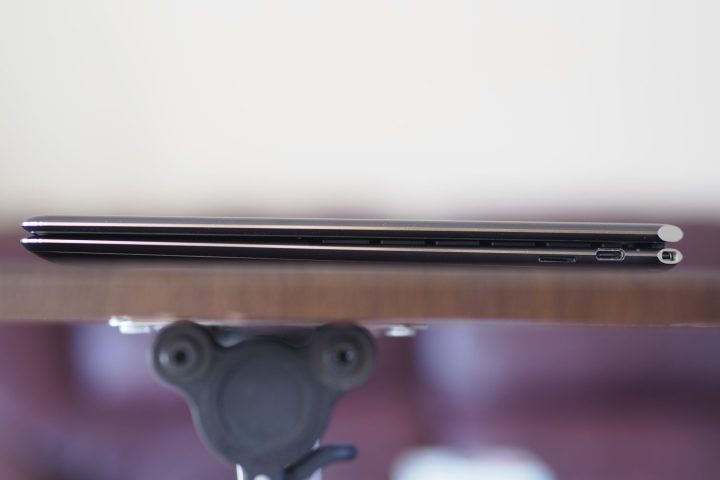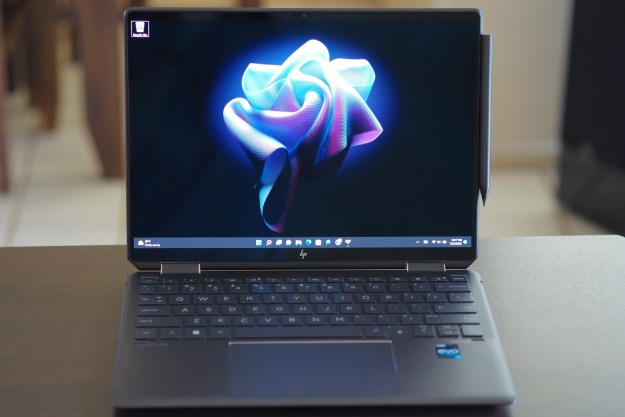
- Elegant aesthetic
- Excellent productivity performance
- Rock-solid build
- Superior keyboard and touchpad
- Stunning OLED display
- Surprisingly good battery life
- Creativity performance is lacking
- Slightly expensive
The HP Spectre x360 has long been some of the best laptops over the years, especially in the category of convertible 2-in-1.
Last year’s 14-inch model, which was excellent, has now been rebranded as the Spectre x360 13.5, still carrying the same size screen but sporting a clean new design.
It’s a bit expensive, but it’s even more attractive this time around, a bonus to the improved performance and battery life. The competition has stiffened, but HP still managed to climb its way back to the top with its flagship.
Price and configurations
I reviewed a $1,700 configuration of the Spectre x360 13.5 with a Core i7-1255U and a 13.5-inch 3:2 3000×2000 OLED display.
The Spectre x360 13.5 is available in several configurations, starting at $1,200 for a Core i5-1235U CPU, 8GB of RAM, a 512GB PCIe 4.0 SSD, and a WUXGA+ (1920 x 1280) IPS touch display. At the high end, you’ll spend $1,840 for a Core i7-1255U, 16GB of RAM, a 2TB SSD, and a 13.5-inch 3:2 3K2K (3000 x 2000) OLED display. If you want the maximum RAM, a $1,780 configuration is available with a Core i7-1255U, 32GB of RAM, a 2TB SSD, and the WUXGA+ display.
I’m not sure why HP hasn’t enabled both the maximum RAM and the OLED display, and perhaps that’s something that will change. My review configuration was $1,700 for a Core i7-1255U, 16GB of RAM, a 1TB SSD, and the OLED display.
The most pertinent competitive laptop at around the same price is the Lenovo Yoga 9i Gen 7, although that 2-in-1 is heavily discounted and a few hundred dollars less than the Spectre. The Lenovo Yoga 7i Gen 7 is less expensive and offers the same CPU but, at the moment, no OLED display option.
Design
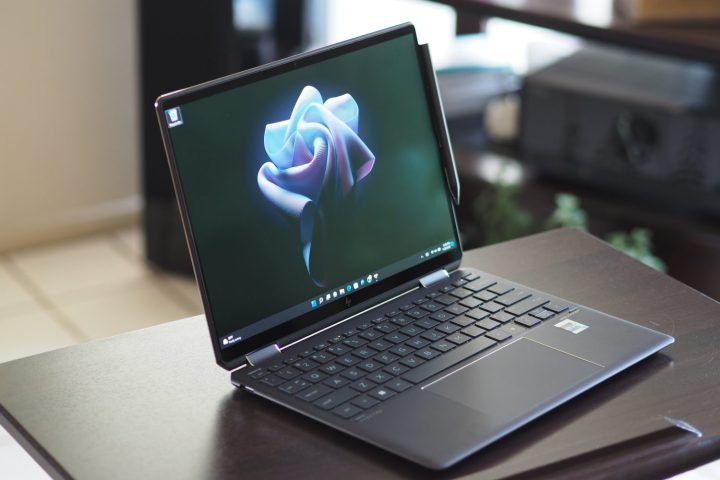
The Spectre x360 14 featured HP’s dramatic gem-cut design with sharply angled edges and notches cut into the rear display and chassis corners. With its rose gold or copper accents, the 2-in-1’s aesthetic was a lovely laptop that stood apart from the crowd. HP scaled back that design with the Spectre x360 13.5, just like it did with the Spectre x360 16, rounding off and slimming the edges and toning down the extravagance. The chassis notches remain functional, with the left hosting the 3.5mm audio jack and the right a USB-C port for keeping the charging cable out of the way.
The result is a more refined look that’s just as elegant and distinctive but not as loud. The rounded edges are also a bit more comfortable to hold in tablet mode, although not as comfortable as the even more rounded edges of the Lenovo Yoga 9i Gen 7.
My review unit sported the Nightfall Black color with brass accents, with optional Natural Silver and Nocturne Blue color schemes with matching edges. In each case, the keyboard matches the primary color. The Spectre x360 13.5’s only aesthetic equals in the 14-inch 2-in-1 crowd are the Yoga 9i Gen 7 and Yoga 7i Gen7, which have rounded and sculpted chassis that are just as attractive in their own way. I’m not saying the rest of the field is boring, exactly, but none are as attractive as these three machines.
Constructed of CNC machined recycled aluminum, the Spectre x360 13.5 is rock-solid.
Constructed of CNC machined-recycled aluminum, the Spectre x360 13.5 is also rock-solid, with no bending, flexing, or twisting anywhere in the lid, keyboard deck, or bottom chassis. It joins the best-built laptops like the Dell XPS 13 and the Lenovo Yoga 9i Gen 7. The only laptop I’ve handled that truly feels more solid is the Apple MacBook Pro 14, and the difference is marginal. Unfortunately, the hinge is just the tiniest bit too stiff to open the lid with one hand, but it holds the display firmly in place in clamshell, tent, media, and tablet modes.
I include the Spectre x360 13.5 in the 14-inch category, but it could easily be lumped in with 13.3-inch laptops just as easily. With the taller display, though, it feels like a 14-inch machine, so that’s how I’m going to treat it. Thanks to narrow bezels and a 90% screen-to-body ratio, the Spectre x360 13.5 is a compact machine. Compared to the Yoga 9i Gen 7, the HP is almost an inch narrower and half an inch shallower, and it’s 0.67 inches thick and 3.01 pounds compared to the Yoga at 0.60 inches and 3.09 pounds.
The latest Dell XPS 13 is smaller, with the Spectre x360 13.5 being an inch wider and deeper. The XPS 13 is thinner at 0.58 inches and lighter at 2.8 pounds. That slots the Spectre x360 13.5 between the Yoga and XPS 13 in every dimension except thickness.
Ports and connectivity
The Spectre x360 13.5 has decent connectivity, with two USB-C ports with Thunderbolt 4 support, a single USB-A 3.2 Gen 2 port, a microSD card reader, and a 3.5mm audio jack. That’s more than the typical 13-inch laptop but less than many 14-inch laptops that include an HDMI port. HP throws in a USB-C hub with two USB-A ports and an HDMI port, which is good to have, but it doesn’t substitute for built-in connections.
Wi-Fi 6E and Bluetooth 5.2 provide the latest in wireless connectivity.
Performance
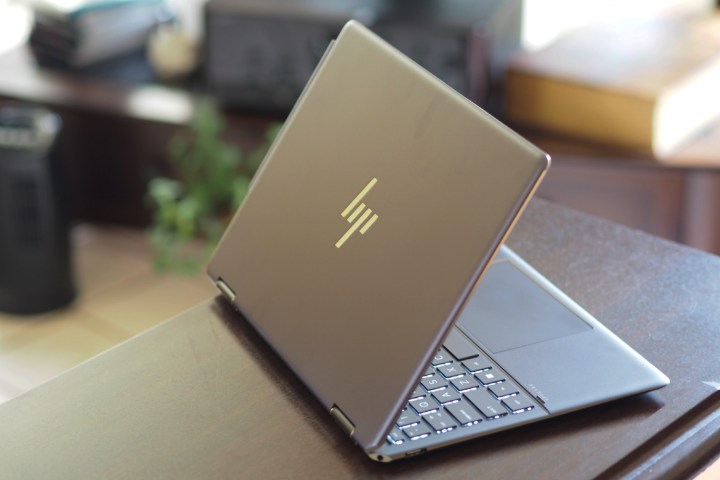
HP opted for a lower-power CPU with the Spectre x360 13.5, specifically the 15-watt 10-core (two performance and eight Efficient), 12-thread Core i7-1255U with a Turbo Boost of 4.7GHz. The Core i5-1255U with a Turbo Boost of 4.4GHz is also available. My review unit equipped the Core i7-1255U, and it performed well compared to the other similarly equipped laptops we’ve reviewed. It was also a massive improvement over the 11th-gen Core i7-1165G7 in the Spectre x360 14. At the same time, unsurprisingly, the Spectre x360 13.5 wasn’t as fast as the Yoga 9i Gen 7 and Acer Swift 3 which were equipped with the 28-watt, 12-core (four Performance and eight Efficient), 16-thread Core i7-1260P.
I used the HP Command Center utility to test both balanced and performance modes. The utility made a significant difference in the CPU-intensive benchmarks, but I did notice that the fans were never extremely loud in either mode. HP updated the thermal design of the Spectre x360 13.5, including adopting new fans that were designed to produce less noise. They did the job. The laptop also didn’t throttle much in either mode, hitting 91 degrees C at most and spending the majority of time in the mid-70s. Given the thin chassis, I suspect HP tuned the machine to avoid generating too much heat, which likely limited performance a bit compared to laptops that are tuned to run hotter but throttle at the high end.
The Spectre x360 13.5 provided excellent productivity performance while running cool and quiet.
In the Geekbench 5 benchmark, the Spectre x360 13.5 fell behind the Lenovo Yoga 7i Gen 7 but was faster in multi-core than the Dell Inspiron 14 2-in-1. It was well behind the Core i7-1260P machines and ahead of the Asus ZenBook S 13 OLED with a 28-watt, eight-core/16-thread AMD Ryzen 7 6800U. In our Handbrake test that encodes a 420MB video as H.265, the Spectre was the fastest among its peers and only slightly behind the higher-watt laptops (in performance mode). In Cinebench R23, the Spectre x360 13.5 was in line with its peers, again in performance mode but well behind the faster machines. Finally, in PCMark 10 Complete, which tests a variety of productivity, multimedia, and creative tasks, the Spectre was competitive with the rest of the comparison group.
Overall, the Spectre x360 13.5 provided excellent productivity performance while running cool and quiet, but as with other laptops with the same CPU, it fell behind in creative tasks. It’s significantly faster than Intel’s previous generation, though, and can tackle some lightweight creative work in a pinch. As we’ll see in the battery life section, the Spectre leveraged the lower-watt CPU’s efficiency better than the other laptops I’ve reviewed.
| Geekbench (single / multi) |
Handbrake (seconds) |
Cinebench R23 (single / multi) |
PCMark 10 Complete |
|
| HP Spectre x360 13.5 (Core i7-1255U) |
Bal: 1,566 / 7,314 Perf: 1,593 / 7,921 |
Bal: 169 Perf: 120 |
Bal: 1,623 / 5,823 Perf: 1,691 / 7,832 |
5,203 |
| HP Spectre x360 14 (Core i7-1165G7) |
Bal: 1,214 / 4,117 Perf: N/A |
Bal: 230 Perf: 189 |
Bal: 1,389 / 3,941 Perf: 1,404 / 4,847 |
4,728 |
| Lenovo Yoga 7i Gen 7 (Core i7-1255U) |
Bal: 1,652 / 8,194 Perf: 1,692 / 8,443 |
Bal: 200 Perf: 141 |
Bal: 1,679 / 7,176 Perf: 1,748 / 7,701 |
5,211 |
| Dell Inspiron 14 2-in-1 (Core i7-1255U) |
Bal: 1,703 / 6,520 Perf: 1,685 / 6,791 |
Bal: 153 Perf: 141 |
Bal: 1,729 / 6,847 Perf: 1,773 / 7,009 |
5,138 |
| Acer Swift 3 2022 (Core i7-1260P) |
Bal: 1,708 / 10,442 Perf: 1,694 / 10,382 |
Bal: 100 Perf: 98 |
Bal: 1,735 / 9,756 Perf: 1,779 / 10,165 |
5,545 |
| Lenovo Yoga 9i 14 Gen 7 (Core i7-1260P) |
Bal: 1,717 / 9,231 Perf: 1,712 / 10,241 |
Bal: 130 Perf: 101 |
Bal: 1,626 / 7,210 Perf: 1,723 / 8,979 |
5,760 |
| Asus ZenBook S 13 OLED (Ryzen 7 6800U) |
Bal: 1,417 / 6,854 Perf: 1,404 / 7,223 |
Bal: 112 Perf: 111 |
Bal: 1,402 / 8,682 Perf: 1,409 / 8,860 |
5,647 |
The Spectre x360 13.5 scored about as expected in the 3DMark Time Spy test, with its score in performance mode being at the top end of the class. Of course, the laptop is limited to Intel’s Iris Xe and won’t be able to play modern titles at anything except 1080p and low graphics. I couldn’t get Fortnite to install, so I couldn’t test the Spectre’s performance in our go-to game for integrated graphics. I’m sure, though, that it wouldn’t have performed any better than other Iris Xe machines.
| 3DMark Time Spy |
Fortnite (1080p/1200p Epic) |
|
| HP Spectre x360 13.5 (Intel Iris Xe) |
Bal: 1,582 Perf: 1,815 |
N/A |
| HP Spectre x360 14 (Intel Iris Xe) |
Bal: 1,457 Perf: 1,709 |
Bal: 19 Perf: 23 |
| Lenovo Yoga 7i Gen 7 (Intel Iris Xe) |
Bal: 1,790 Perf: 1,716 |
Bal: 18 Perf: 18 |
| Dell Inspiron 14 2-in-1 (Intel Iris Xe) |
Bal: 1,492 Perf: 1,502 |
Bal: 12 fps Perf: 12 fps |
| Acer Swift 3 2022 (Intel Iris Xe) |
Bal: 1,967 Perf: 1,967 |
Bal: 19 Perf: 19 |
| Lenovo Yoga 9i 14 Gen 7 (Intel Iris Xe) |
Bal: 1,658 Perf: 1,979 |
Bal: 12 fps Perf: N/A |
| Asus ZenBook S 13 OLED (Radeon graphics) |
Bal: 2,110 Perf: 2,213 |
Bal: 19 fps Perf: 19 fps |
Display and audio
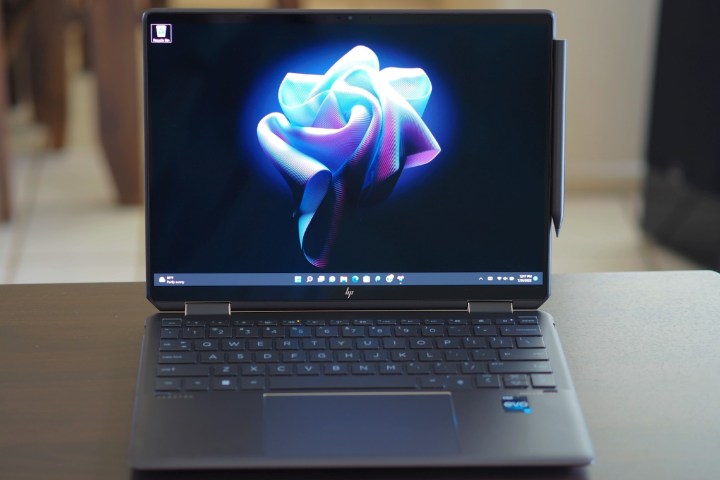
As usual, the Spectre x360 13.5’s 13.5-inch 3:2 OLED display was gorgeous from the second I fired it up. It’s sharp enough at a resolution of 3000 x 2000 and colorful and bright with deep, inky blacks. HP also offers a WUXGA+ (1920 x 1280) IPS display and a WUXGA+ display with HP’s privacy screen.
My colorimeter loved this display. It was bright at 380 nits, above our 300-nit standard, and bright enough for any indoor setting. Its colors were wide at 100% of sRGB and 97% of AdobeRGB and incredibly accurate with a DeltaE of 0.61 (1.0 or less is indistinguishable to the human eye). And its contrast hit the OLED standard at 28,230:1. The three OLED displays in the comparison group were almost equal in quality, with the Spectre having the widest and most accurate colors.
Whether you’re doing productivity work, binging Netflix, or working with images and video, you’ll love this display. And it’s not just the brightness, colors, and contrast but also the aspect ratio, which at 3:2 is the closest to a physical piece of paper in portrait mode and thus optimal for tablet use.
| Brightness (nits) |
Contrast | sRGB gamut | AdobeRGB gamut | Accuracy DeltaE (lower is better) |
|
| HP Spectre x360 13.5 (OLED) |
380 | 28,230:1 | 100% | 97% | 0.61 |
| Lenovo Yoga 7i Gen 7 (IPS) |
321 | 1,380:1 | 99% | 80% | 1.89 |
| Lenovo Yoga 9i Gen 7 (OLED) |
406 | 28,380:1 | 100% | 95% | 0.87 |
| Lenovo ThinkPad X1 Yoga Gen 7 (IPS) |
386 | 1,900:1 | 100% | 81% | 0.78 |
| MSI Summit E14 Flip (IPS) |
516 | 1,320:1 | 100% | 89% | 1.10 |
| Lenovo IdeaPad Slim 7 Carbon (OLED) |
397 | 27,590:1 | 100% | 96% | 0.88 |
Four downward-firing speakers provide plenty of volumes, with crisp and clean mids and highs. There’s not a lot of bass, and so the Spectre x360 13.5’s audio can’t keep up with the best around, Apple’s MacBooks. Still, the audio is good enough for binging Netflix and listening to the occasional tune. Of course, audiophiles will still prefer a good pair of headphones.
Keyboard and touchpad

HP’s Spectre line has long offered some of the best keyboards in Windows laptops, with only Apple’s latest MacBook Pro Magic Keyboard being better. That remains true with the Spectre x360 13.5, although the keyboard isn’t exactly the same as previous models.
Interestingly, HP dropped the convenient row of navigation keys along the right-hand side, which I miss, but I appreciate the extra key spacing. The keycaps are also large, making for a very efficient layout. As before, the switches are light and snappy with a precise bottoming action. It’s one of the most comfortable keyboards I’ve used for long typing sessions. One nit to pick is that HP dropped the right Ctrl key in favor of a fingerprint reader.
The touchpad is large and takes up most of the space on the palm rest, which is larger than usual thanks to the taller 3:2 display. The touchpad surface is smooth and provides a precise surface for Windows 11’s multitouch gestures, and the buttons have a nice click without being too loud. Outside of Apple’s Force Touch touchpad or Dell’s haptic touchpad on the XPS 13 Plus, it’s one of the best touchpads you’ll find.
The display is touch-enabled, of course, and supports HP’s active pen that’s included in the box. I found the pen’s Windows Ink support to be excellent thanks to 4,096 levels of pressure sensitivity and tilt support, and it conveniently attaches magnetically to the right side of the display. The pen charges via USB-C, which is another convenience.
Windows 11 Hello passwordless login is supported by an infrared camera, facial recognition, and the fingerprint reader mentioned previously. Both methods worked quickly and reliably.
Webcam

HP has outfitted the Spectre x360 13.5 with a 5MP webcam that provides a high-resolution image, and several software tools optimize the videoconferencing experience. HP Presence provides Auto Frame to keep the user’s face in view as they move around the office during a call, Backlight Adjustment that ensures consistent lighting no matter the ambient environment, and Appearance Filter that smooths out blemishes that other webcams might highlight. Several audio enhancements also improve the experience, including directional beamforming mics and bi-directional AI noise reduction.
There’s a key to electronically close a physical shutter over the webcam, along with a key to turn off the microphones. That provides for some extra privacy.
Battery life

The Spectre x360 13.5 has 66 watt-hours of battery capacity, a slight decrease from the previous generation’s 67 watt-hours. That’s a fair amount, more than the Lenovo ThinkPad X1 Yoga Gen 7’s 57 watt-hours but less than the Yoga 9i Gen 7’s 75 watt-hours. Both the Spectre and Yoga 9i used power-hungry OLED displays, and so I was looking forward to seeing if HP managed to exploit the lower-watt CPU’s presumed efficiency advantage.
According to our suite of benchmarks, HP did something right — the Spectre x360 13.5 lasted surprisingly long in our suite of battery tests. Looking back at the performance section, it’s clear that HP tuned the laptop to run more efficiently in balanced mode at the expense of performance. That’s a reasonable tradeoff, with the Spectre being more than fast enough for typical productivity tasks while achieving excellent battery life.
In our web browsing test, for example, it lasted for 10 hours, which is an excellent score, particularly for a laptop with an OLED display. The Spectre made it to 11 hours in the PCMark 10 Applications battery test, which is the best predictor of battery life running a typical (i.e., non-demanding) productivity workflow. And in our video test that loops a local 1080p movie trailer, it lasted for 14 hours, another strong showing given the OLED display. The only laptop in our comparison group that competed with the Spectre x360 13.5 in all but the web browsing test, where it was almost three hours behind, was the Lenovo ThinkPad X1 Yoga Gen 7, and it benefitted from a low-power Full HD+ IPS display.
You don’t often get OLED quality and long battery life, but the Spectre x360 13.5 delivers. You should be able to work for a full day of typical productivity tasks and maybe even have a little time left over.
| Web browsing | Video | PCMark 10 Applications |
|
| HP Spectre x360 13.5 (Core i7-1255U) |
9 hours, 58 minutes | 13 hours, 59 minutes | 10 hours, 52 minutes |
| HP Spectre x360 14 (Core i7-1165G7) |
6 hours, 57 minutes | 10 hours, 16 minutes | 9 hours, 8 minutes |
| Lenovo Yoga 7i Gen 7 (Core i7-1255U) |
7 hours, 7 minutes | 13 hours, 53 minutes | 10 hours, 41 minutes |
| Dell Inspiron 14 2-in-1 (Core i7-1255U) |
6 hours, 42 minutes | 10 hours, 6 minutes | 8 hours, 43 minutes |
| Lenovo Yoga 9i Gen 7 (Core i7-1260P) |
6 hours, 57 minutes | 10 hours, 16 minutes | 9 hours, 8 minutes |
| Lenovo ThinkPad X1 Yoga Gen 7 (Core i7-1260P) |
10 hours, 10 minutes | 16 hours, 12 minutes | 10 hours, 33 minutes |
| Asus Zenbook S 13 OLED (Ryzen 7 6800U) |
8 hours, 4 minutes | 13 hours, 13 minutes | N/A |
Our take
The Spectre x360 13.5 is precisely what HP needed to produce to follow up on the success of the Spectre x360 14. The new 2-in-1 is faster, offers significantly better battery life, has a more refined look, and retains the excellent keyboard and touchpad of the previous model.
I’m giving the Spectre x360 13.5 a 9/10 score, one notch less than the Spectre x360 14, not because the update isn’t as good. It’s because the competition has gotten so much better. HP’s latest regains its spot as the best convertible 2-in-1, but the gap between it and the next best isn’t quite so large.
Are there any alternatives?
The strongest alternative is the Lenovo Yoga 9i Gen 7. It’s just as good-looking, as well built, and slightly faster. But its battery life isn’t nearly as good, and its keyboard and touchpad are a step behind. It’s a little less expensive, though, and so makes for a solid choice.
If you don’t need a 2-in-1, then Dell’s new XPS 13 Plus is an attractive option. It’s faster and enjoys its own stunning new design, incorporating innovations like an excellent haptic touchpad. You’ll spend about the same money and get a clamshell that’s among the best available today.
My final recommendation is the Apple MacBook Air M2. It’s equally solid, if not slightly more so, it offers better performance and battery life, and its display is excellent even if not quite up to OLED standards. You’ll spend around the same money, and the MacBook is a compelling alternative if you’re okay with MacOS.
How long will it last?
The Spectre x350 13.5 is incredibly well-built and will last for years, which its modern components will also support. The industry-standard one-year warranty is a disappointment, as always.
Should you buy it?
Yes. Solid productivity performance and excellent battery life in a nicely sized, thin and light 2-in-1 with a spectacular OLED display — what’s not to like?


